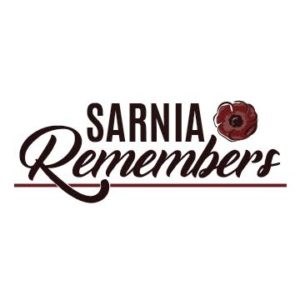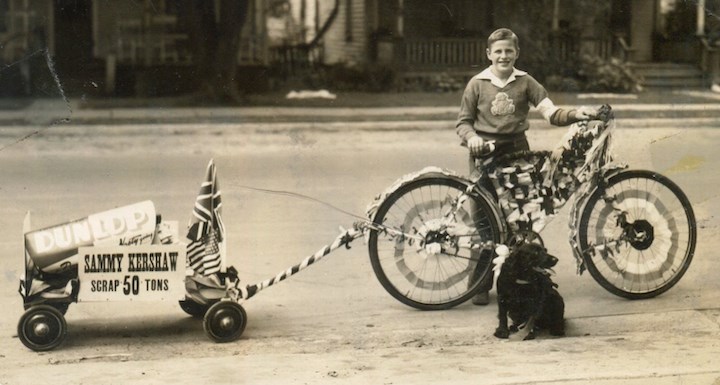 By Tom St. Amand and Tom Slater
By Tom St. Amand and Tom Slater
On October 31, 1944, J. O. Laird, the Provincial Organizer of the Department of National War Service, wrote a personal letter to Sarnia resident, Sam Kershaw. On behalf of the government, Mr. Laird informed Sam that since Canada's war effort was most in need of “paper and rags… could [you] concentrate mostly on these two materials? However, grease is also very acceptable and very necessary.”
The Canadian government knew whom to approach if it wanted to acquire essential materials like metal, rubber, paper, cloths, grease and glass—anything really that could be salvaged from the home front and used to keep the Allied war machine running overseas. The go-to person in Sarnia was Sam Kershaw.
By 1944, Sam Kershaw was a seasoned salvager and Sarnia's not so secret weapon for the Allies at home. On his own time and with no salary, he had been salvaging and donating items from Sarnians for the past three years. By the time the war ended in 1945, Sam had set a national record for the most materials collected by an individual for the war effort.
In total, he donated 50 tons of material, a staggering sum. To put that figure in perspective, it's the equivalent weight of a typical cumulus cloud or 25 Ford F-150 pickup trucks.
Fifty tons.
It was little wonder news articles in Sarnia and throughout Canada referred to Sam as a ‘one-man salvage agency’; ‘Sarnia's Super Salvage Sleuth’; ‘Sarnia's One-Man Scrap Committee’; and ‘Canada's Man of Action.’
What made Sam's efforts and accomplishments even more mind-boggling was that when he started collecting in the summer of 1941, he was only seven years old. That's not a misprint. Before he entered grade three and until he finished grade seven, Sam (better known then as ‘Sammy’ or ‘Little Sammy’) not only did his part for our soldiers during the day, but also found time to finish his homework at night.
Sammy was the youngest of ten children, born in 1933 to Harriet and Robert, a sewing machine repairman and a baker by trade. Johnny, Sammy's older brother was serving in the navy, so he wanted to do his part to help. Perhaps with a little encouragement from his mother, Sammy got into “the salvage business” as one reporter put it. According to Sammy's son, Brian, his father “was not going to let his older brother outshine him, so he turned to salvaging to help soldiers.”
Once he started collecting in 1941, he never stopped until the war was over. Sammy soon became a familiar sight to residents: a boy, not yet five feet tall, tugging his trademark wagon up and down the sidewalks and streets of Sarnia and stopping at houses, stores, and restaurants to ask for donations. The arrangement was that he would donate anything he collected to the Red Cross Conservation Committee on Queen Street. They saw a lot of Sammy for four years.
He was not alone, of course. Throughout Canada, almost everyone knew someone—a family member, friend, or neighbour—who was serving overseas, and Canadians at home wanted to support the war effort. In Sarnia, residents rationed their meals, donated blood, and exchanged food stamps; volunteered with organizations which made and sold crafts; contributed and invested in War Savings Certificates and Victory Bonds; and knitted socks, sweaters, blankets, and scarves for the soldiers. What they didn't donate, they sold and the money generated from the sales was used to purchase more goods for our soldiers.
When enemy conquests cut off supplies of crucial raw materials such as tin and rubber, the need for products made from these materials skyrocketed. Ordinary citizens were encouraged to save and to donate materials useful for the war effort; for example, bacon grease produced glycerin which, in turn, created bombs, gunpowder, and other munitions; scrap metal was used for bombs, ammunition, tanks, guns, and battleships; rubber was essential for gas masks, life rafts, cars, and bombers.
Sammy’s first salvaging foray was auspicious. The Kershaws lived at 116 Mitton Street South during the war, and the adage “charity begins at home” was true with the Kershaws—at least to a point. Within no time, Sammy had rooted through the family basement and property and somehow had managed to load seven car tires onto his wagon. He started lugging his cart to the Red Cross but, just in time, his dad stopped him. Sammy's eager hands had lifted two tires from the family car. Without tires, Robert explained to him, our car won't run. Despite this setback, Sammy still salvaged five tires and two copper boilers from his parents' belongings on his first day. Not a bad start.
And things just got better. Often Sammy's cart was so laden with scrap that he was bent over double as he hauled his cart to the Red Cross. He collected in the morning before school and again at 4:00 when the school day ended. For a while, he was collecting during his lunch break, but Harriet was concerned her youngest child was not eating properly and demanded that he take time off to eat a proper meal. When he wasn't in school, he'd be out collecting and weekends were never spent in idle pursuits. Sammy was on a mission. When he had finished approaching residents on all of Sarnia's streets, he ventured into Point Edward.
In over four years, he salvaged an average of 68 pounds (30 kilograms) of materials per day. A typical day saw him collect 50 license plates and dozens of rubber shoes. Another day, he brought dozens of magazines and over 500 metal coat hangers to the Red Cross. Nothing escaped his eye and no piece of material was too small. His age and size notwithstanding, Sammy had brawn as well as brains. As he found scraps, he scouted for future salvage sites and potential materials. When he heard a local bakery was getting new bread racks and ovens, he called for weeks, reminding the owners that he'd love to have them for his salvage collection. Two months later, he was rewarded and carted the ovens and racks away.
Day by day, Sammy's reputation as a tireless salvager grew and people took notice. Soon word spread and people began calling the Kershaw home to make arrangements with Sammy for the pick-up of materials.
Sammy never grumbled or complained when he collected, and what he couldn't carry, he rolled if possible. He was energetic and determined and always remembered to thank those who donated items. This attitude accounted for part of his success. Another part, a bigger part perhaps, was his age. “It's pretty hard, I think, for people to refuse a little boy,” he reasoned. “They don't want to not help with the war effort at home, and if a nine-year-old boy is out doing something to help Canada, the least we can do is help him.”
Sammy did not receive nor did he want any money for the salvaging efforts. In appreciation for all he was doing, the Sarnia Kiwanis Club bought him a bicycle during the war to make his task easier. Sammy hooked his wagon onto his bike and covered the city streets faster. Unfortunately, someone stole his bike days later but, fortunately, Sammy won a new bike in a customer contest put on by the Sarnia Circulation Department. When a neighbour noticed his trusty wagon had fallen into disrepair from all the material it had carried, a good citizen anonymously donated $1.00 to purchase a new one for him.
During and after the war, accolades poured in, but Sammy always remained humble about his own contributions to the war effort. In 1943, when someone asked him why he was doing so much, his reply was simple: “It’s helping to win the war.” Sarnia City Council commended Sammy publicly for his “splendid work” and “untiring efforts.” He received an Award of Merit from the Red Cross Society in March 1945 for his “outstanding work”, and he became a gold member of the Eaton Good Deed Radio Club shortly after the war ended.

One award in particular must have appealed to ten-year-old Sammy. In 1943, he was made an honourary member of the Captain Jack Club, a popular cartoon among children across Canada that recognized the outstanding efforts of real Canadians. In a full-sized cartoon, Captain Jack, a muscular gymnast, is letting all the young readers know that Sammy “in 10 months rounded up 11,329 pounds of salvage.” On the right of the frame is an accurate sketch of Sammy, smiling as he hauled his familiar wagon. For a kid in the 1940s, it didn’t get better than this.
After the war, Sam Kershaw stayed in Sarnia and married Margaret Hornick. Together they raised two children, Brian and Kim, and Sam worked at CN Railway for 39 years. In his spare time he was a sewing machine repairman for 60 years.
As an adult, Sam had changed little from his days of salvaging during the war. He was, according to his daughter, Kim, “a truly decent and humble person” and as the years passed, he hated to see anything of value thrown out. Sam, not surprisingly, purchased a metal detector and his garage soon became crammed with items that he had collected over the years.
Sam Kershaw passed away in 2016, but the legacy of his wartime efforts lives on. He had been too young to serve overseas during the war, but serve he did. In 1945, a city councillor summarized his contribution with these words: “There are heroes at the front. And there are heroes at home too. Sammy is one of those.”
St. Amand and Slater are the authors of Valour Remembered: Sarnia-Lambton War Stories, available at The Book Keeper.
